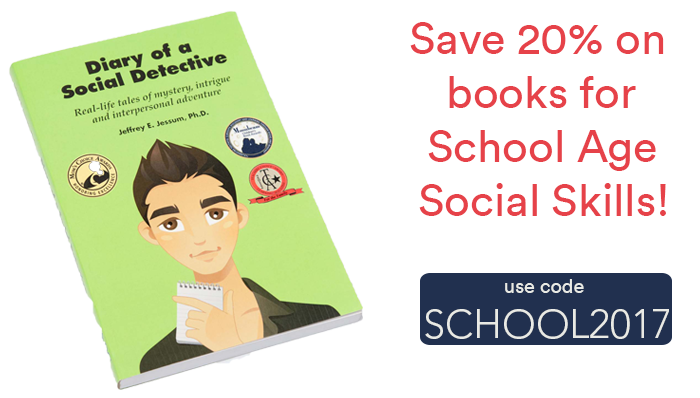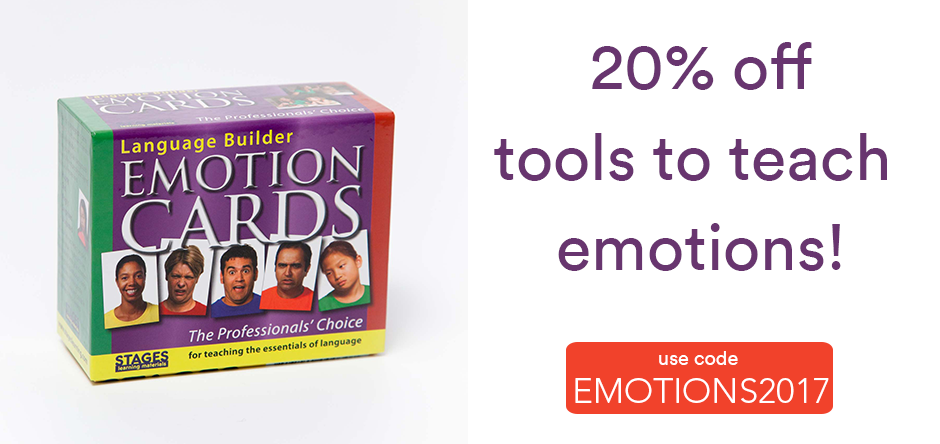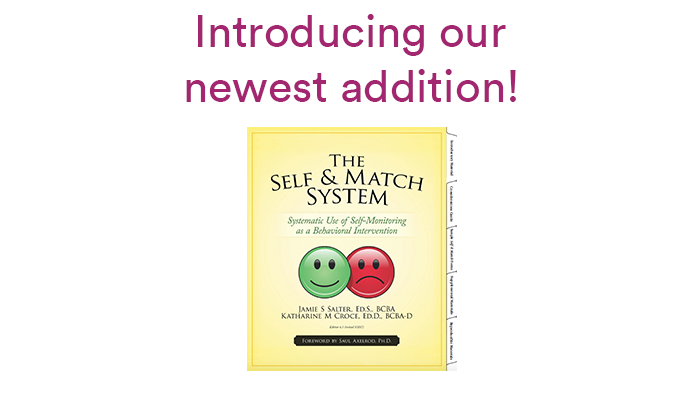Category Archives: autistic spectrum disorder
Pick of the Week: Social Skills Books!
Kick off the school year with select books for teaching social skills, now 20% off!
*Promotion is valid until September 4th, 2017 at 11:59pm ET. Offer cannot be applied to previous purchases, combined with any other offers, transferred, refunded, or redeemed and/or exchanged for cash or credit. Different Roads to Learning reserves the right to change or cancel this promotion at any time. To redeem offer at differentroads.com, enter promo code SCHOOL2017 at checkout.
Pick of the Week: Teaching Sight Words!
Teach sentence building and basic conversation skills with these terrific language tools! 20% off with code WORDS2017 at checkout!
*Promotion is valid until August 28th 2017 at 11:59pm ET. Offer cannot be applied to previous purchases, combined with any other offers, transferred, refunded, or redeemed and/or exchanged for cash or credit. Different Roads to Learning reserves the right to change or cancel this promotion at any time. To redeem offer at differentroads.com, enter promo code
WORDS2017 at checkout.
Discussing Concerns With Family Members
This month’s ASAT feature comes to us from Peggy Halliday, MEd, BCBA and David Celiberti, PhD, BCBA-D. To learn more about ASAT, please visit their website at www.asatonline.org. You can also sign up for ASAT’s free newsletter, Science in Autism Treatment, and like them on Facebook!
I am concerned that my two year old grandson may have signs of autism, but I am uncomfortable bringing this up with my son and daughter-in-law. Do you have any suggestions about how best to approach them?
It is natural to be unsure of how to share your concerns with your grandson’s parents. As is the case with many concerned family members, you may worry that such a discussion will not be well received or may cause some discomfort or tension in your relationship. If autism is a possibility, you would not want to delay screening and referral for possible evaluation and services because this may waste valuable time during which intervention can be most beneficial for your grandson. Even knowing that the best outcomes are associated with early diagnosis and intensive intervention, it still may be difficult to talk to your son and daughter-in-law if they have not expressed their concerns to you.
As a grandparent, you have already raised at least one child, so you probably have a good sense of what is typical in child development, and what is not. You may feel that your grandson is not making expected gains or may appear delayed in some areas such as communication or play relative to other children his age. Also, you may not have day to day contact so slower development of skills may be more apparent to you. This may create a sense of urgency in you that should be balanced with the need to support your son and daughter-in-law.
There are several important considerations. The way in which you approach your son and daughter-in-law will depend in large part on the quality of your pre-existing relationship and on the nature of how you communicate with one another. You may possess a relationship where difficult issues are frequently and easily discussed. On the other hand, this may not typify the type of relationship that you have. Regardless of your relationship, it is important that you bring this up from a place of love and concern, rather than judgment and blame. Many parents who have been carefully and respectfully approached by a relative later admit that they already had concerns of their own, and it was a relief to discuss them with someone else close to the child.
We would like to offer some concrete suggestions that may increase the likelihood that your discussion will be positive and constructive.
Planning Ahead:
- Take some time to think about what you want to share and how you want to frame your concerns. You might begin by commenting on the child’s strengths and praising the parents’ love and dedication to their child. It is important not to appear judgmental or focused only on the concerns.
- Plan your discussion ahead of time. Find a time and place when you will not be interrupted. It may be best when the child is with another caregiver.
- The role you take in the child’s life depends, of course, on geographic proximity, but be poised to offer concrete, practical help whenever possible. For example, you might offer to babysit siblings while parents pursue evaluation of the child, or offer a respite weekend of childcare so that your son and daughter-in-law might have time to discuss the situation without interruption. Whatever assistance you offer, the important thing is that your grandson’s parents perceive it to be helpful, so try and gauge their reactions carefully.
Having the Conversation:
- Try to keep the conversation free flowing. You may want to ask a few questions that will allow the parents to express their own concerns, if they have them (e.g., “I noticed that Billy became very upset when the phone rang. Has that happened before?” or “Does he seek you out when he is upset?”).
- Avoid labels and technical terms, which may trigger fear or upset from the parents. Focus instead on discussing milestones, which are observable indicators of a child’s development and accomplishments.
- In some cases, it may be beneficial to think about the discussion as a series of tiny conversations. This would be more appropriate if you have frequent contact with your son or daughter-in-law. It may then be helpful to share some observations that may provide a backdrop for later discussion (e.g., “Little Peter seems overwhelmed by noise levels.” or “I have noticed that he does not seem to know how to use words to get his needs met.). It may also be helpful to discuss observations surrounding worrisome or absent peer or sibling interaction.
- Emphasize the need to simply get any concerns checked out in order to “rule out” anything serious or to get some guidance and support in how to promote skill development. You might follow this up by mentioning that the earlier a potential problem is recognized and addressed, the easier it is to help the child.
Other Considerations:
- Most parents begin to become concerned that something may be wrong when their child is between the ages of 12 and 18 months. If the parents are beginning to realize a potential problem exists, you want to gently urge them not to delay a preliminary assessment and evaluation.
- You should never take for granted that developmental concerns will automatically be addressed during routine visits to the pediatrician. Refer parents to resources such as good websites and resources they can explore on their own (we emphasize the word “good” as there is a tremendous amount of misinformation about autism both in the media and on the Internet, particularly many false promises about autism treatment). The most helpful websites at this stage are typically the ones that discuss developmental milestones. Parents often know when to expect their infant and toddler to sit up or take their first steps, but they do not know when they should begin to babble with inflection, point to things they notice or want, imitate gestures, or show interest in another child.
- If the child is in a daycare, speak to his or her teachers and directors about the child’s progress. They should be keeping records on how the child is developing in different areas such as social interaction, verbalization, etc. They are also a good resource to use to help evaluate your child in a school setting.
The following websites include milestones checklists, booklets, and charts, and a wealth of other helpful information.
- Association for Science in Autism Treatment (ASAT): On the ASAT website, you will find extensive information about the scientific support (or lack thereof) behind the full array of treatments proposed for autism, research reviews, articles and guidelines on how to make informed choices, and weigh evidence in selecting treatment options, a section of frequently asked questions such as the one you asked, information about upcoming conferences of interest, and links to helpful sites and other science-based organizations.
- Centers for Disease Control and Prevention: The Act Early website contains an interactive and easy- to-use milestones checklist you can create and periodically update for children ages three months through five years, tips on sharing concerns with the child’s doctor, and free materials you can order, including fact sheets, resource kits, and growth charts.
- First Signs: The First Signs website contains a variety of helpful resources related to recognizing the first signs of autism spectrum disorder, and the screening and referral process. There is a directory of local resources for at least eight states and that number is likely to increase over time.
- American Academy of Pediatrics (AAP): The AAP website contains information for families, links to many other web sites, information about pediatrician surveillance and screening, and early intervention. This site contains great tools for pediatricians, as well as parents.
- Autism Speaks: The Autism Speaks website includes an Autism Spectrum Disorder Video Glossary of clips designed to help parents and professionals learn more about the early ‘red flags’ of autism, information about how autism is diagnosed, and a resource library. They also offer a free 100 Day Kit designed to help families of newly diagnosed children make the most of the first 100 days following a diagnosis of autism.
About The Authors
Peggy Halliday, MEd, BCBA, is a Board Member of ASAT, and serves as the JCH Director of School Consultation at the Virginia Institute of Autism (VIA) in Charlottesville, Virginia, where she has been a practitioner since 1998. Peggy oversees trainings for parents and professionals and provides consultation to public school divisions throughout Virginia. She also oversees BCBA and BCaBA training experiences. In addition to serving as a presenter at state and national conferences, including the Organization for Autism Research (OAR), Commonwealth Autism Service (CAS), and Association for Behavior Analysis International (ABAI) Peggy was selected as an autism expert for the “how-to” website monkeysee.com. Peggy has been on the board of ASAT since 2010 and serves on the Public Relations Committee.
David Celiberti, PhD, BCBA-D, is the part time Executive Director of ASAT and Past-President, a role he served from 2006 and 2012. He is the Co-Editor of ASAT’s newsletter, Science in Autism Treatment. He received his PhD in clinical psychology from Rutgers University in 1993. Dr. Celiberti has served on a number of advisory boards and special interest groups in the field of autism, applied behavior analysis, and early childhood education, and been an active participant in local fundraising initiatives to support after school programming for economically disadvantaged children. He works in private practice and provides consultation to public and private schools and agencies in underserved areas. He has authored several articles in professional journals and presents frequently at regional, national, and international conferences. In prior positions, Dr. Celiberti taught courses related to applied behavior analysis (ABA) at both the undergraduate and graduate levels, supervised individuals pursuing BCBA certifications, and conducted research in the areas of ABA, family intervention, and autism.
Pick of the Week: Emotions!
Save on select tools to help young learners recognize emotions!
*Promotion is valid until July 31st 2017 at 11:59pm ET. Offer cannot be applied to previous purchases, combined with any other offers, transferred, refunded, or redeemed and/or exchanged for cash or credit. Different Roads to Learning reserves the right to change or cancel this promotion at any time. To redeem offer at differentroads.com, enter promo code
EMOTIONS2017 at checkout.
Got Questions: Help for Socially Anxious Preschooler Who Has Autism
This piece originally appeared at Autism Speaks as part of their Got Questions? series.
My almost 3-year-old was recently diagnosed as having autism spectrum disorder. We struggle going places such as open gym or even the library because he doesn’t like other kids in his space. He does okay with adults, but other kids make him extremely anxious. How do I help him become more comfortable when other children are playing in the same area or with the same set of toys?
I commend you for seeking support for your son at this young age. Receiving a diagnosis of autism spectrum disorder can be challenging and confusing. Yet research shows that early intervention can help maximize cognitive, language and social development.
In my pre-doctoral work at UCLA and my post-doctoral training at Pediatric Minds Early Childhood Treatment Center, my colleagues and I have seen many forms of anxiety in children and teens who have autism. Like your son, many of them experience anxiety around other children, especially groups of children. Understanding the reasons for this anxiety can help select approaches that help.
For example, you mention that your son “does okay” with adults, but not other kids. This is very common. While adults tend to be more consistently friendly and accommodating, children can be very unpredictable. For instance, it’s not unusual for three-year-olds to grab toys from each other, cry, get very close to each other and just be loud! This can be particularly anxiety provoking for someone with autism.
In addition, many people with autism are hypersensitive to sensory input. As a result, public places such as open gyms or even a lively children’s library can be over-stimulating. The sights, sounds and smells can feel intense, uncomfortable and overwhelming. Understandably, this can lead a child to avoid these environments and become upset in the midst of them.
I strongly encourage you to work with your son’s therapists to develop a personalized intervention plan. Children with autism who are under age 3 can qualify for such services through their state’s Early Intervention program. After age 3, these services can be accessed as part of an Individualized Education Plan (IEP) through your school district.
Also see “Access autism services,” for more information on early intervention and individualized education services.
Fortunately, many programs are available to help young children with the type of social anxiety you describe. These include play-based forms of Applied Behavioral Analysis, occupational therapy that includes sensory integration, communication-focused intervention, social skills play groups and other options. Many children do best with a multidisciplinary approach that combines two or more of these methods with close collaboration among the care providers.
Also see, “Autism therapies and supports,” in the “What is autism?” section of this website. While every child has different needs, here are some strategies you can try – ideally in collaboration with your son’s therapists.
Practice. Are there specific social situations that tend to trigger your son’s anxiety? For instance, does he get upset when another child tries to take his hand or pull him into a game? Consider teaching him simple phrases he can use in these situations. For example, a simple “no.” You can also teach and practice toy sharing and turn taking at home. If your child enjoys play dough, for example, place just a few pieces on the table and take turns modeling each of the pieces, handing them back and forth. This can help him learn sharing and even waiting for gradually increasingly periods before getting what he wants. These skills can be difficult to learn. So start with brief periods of waiting and offer plenty of praise along the way. Providing this type of structured opportunities to practice social skills can encourage your son to use them in social settings.
Start slow. A room full of children may be too overwhelming for your child to use the new skills that he’s practiced with you at home. Consider hosting a playdate with one other child who is relatively calm and engaging. Sometimes, a slightly older child will understand how to be more accommodating.
In selecting where to have the playdate, consider your son’s comfort level. You might start at home or maybe a relatively quiet place at a nearby park.
Choose some relatively structured activities such as games or sharable toys that your child knows and likes. Keep the playdates relatively short to further the chances of success.
Bring the familiar. When entering a loud or anxiety producing environment, a comfort object may help provide a sense of security in an otherwise overwhelming environment. Consider allowing your son to bring a familiar toy, stuffed animal or book. Another possibility is a toy or game that actively engages his attention – and so directs his attention away from the hubbub around him.
Be patient. I encourage parents to appreciate that their child’s stage of development may not match what’s typical for his or her age. This is particularly true of social development in children on the autism spectrum. By focusing on small steps, you can foster your child’s confidence and decrease the likelihood of setbacks.
Remember, your child – like all children – is continually developing. You can support his social development – while decreasing anxiety around other children – by providing ample opportunities for success.
About The Author
Dr. John Danial is a 2012 Autism Speaks Weatherstone predoctoral fellow. Dr. Danial’s fellowship supported his work with mentor Jeffrey Wood at the University of California, Los Angeles, developing and evaluating behavioral interventions that reduce anxiety in children, teens and adults with autism and low verbal skills. He is currently completing his post-doctoral placement at Pediatric Minds Early Childhood Center, working with families of children with developmental delays and social-emotional challenges.
Pick of the Week: Photographic Language Cards!
*Promotion is valid until August 14th 2017 at 11:59pm ET. Offer cannot be applied to previous purchases, combined with any other offers, transferred, refunded, or redeemed and/or exchanged for cash or credit. Different Roads to Learning reserves the right to change or cancel this promotion at any time. To redeem offer at differentroads.com, enter promo code
CARDS2017 at checkout.
NAVIGATING SESAME PLACE WITH A CHILD WITH AUTISM
This week’s post originally appeared on INCLUDEnyc,
As a mom of a three-year-old with autism, sometimes I’m hesitant to visit places that are overcrowded with people. I always worry that my son Julian will become overwhelmed and have a meltdown. Recently, his daycare took him on a trip to Sesame Place, and despite my worries, I decided to attend. I also invited a friend who has a five-year-old son with autism named Brandon (who is one of Julian’s BFFs).
I created a social story for Julian and told him about all of the characters he would see when we went there. I let him know that we would be playing in the water, going to see Elmo, and that we were going to go on fast rides that went up and down. I spoke to him about Brandon coming with us and how we would be taking a bus. He was very excited and told me he was very happy; or, in his words, “Mommy, Juju happy” (he refers to himself in the third person and always calls himself by his nickname).
The morning of the trip it was a little shaky; we took a car to his school (he was not happy about this because Mommy had only mentioned a bus). When we got on the bus, he was upset and overwhelmed with all of the new changes in his routine. I won’t lie — I was feeling a little overwhelmed myself. It took about 15 minutes for him to calm down, but after that he watched the cars as they drove by and ate lots of snacks, watched parts of a movie that was playing, and climbed all over me. In the end, he didn’t scream and cry the whole time, he didn’t get sick, and best of all, we made it in one piece.
When we arrived at Sesame Place we went straight to the Welcome Center, which was right by the entry gates and, oddly enough, not packed. I told the woman at the desk that we were traveling with two amazing little boys with autism. We were asked basic information like our boys’ names, birthdates, heights and addresses and we were each given a plastic wrist band with the numbers 1-3 on it (each number had a tab that ripped off the band) for water rides. This wristband allowed us to enter the rides through “Abby’s Magic Queue” and skip the long lines 3 times (good for 4 people each time). We were also given a small card with the numbers 1-6, which allowed us to ride 6 dry rides (good for 4 people each ride). We also rented a double stroller for less than $20 which allowed us to stroll both boys and carry our bags easily.
First we did the water rides. We went on a raft/slide ride near the entrance about 4 times in a row. Lucky for us they didn’t ask for any of the tabs. Both boys had a hard time waiting their turn but equally loved the ride; the smiles on their faces were priceless. Next we did the lazy river (for this ride they took one of our tabs); we were able to do this one twice as well. There are some parts on the lazy river where you will get splashed or sprayed by water; we just used ourselves as shields to block them (none of the boys like water in their faces). By the time we finished the lazy river, it was time for lunch. We had chicken fingers and French fries (which only came out to about $30 with a souvenir cup and plate).
Next we went on the dry rides and did just about everything in the Elmo’s World section of the park. For the dry rides we went to the exit and handed our cards to the attendant. They crossed off one number from the card and we were allowed to board the ride first. We had lots of fun on the spinning cups and air balloons. Apparently Julian has a thing for rides that go high in the air (me, not so much; I am afraid of heights). We also went to take a picture with Abby and Elmo, and we were super lucky that there was no line at all.
When it was time to leave, we got to watch some of the parade and wave to some of our favorite characters. Julian was very upset that we had to go and started to cry. Brandon was able to help soothe him by taking his hand and telling him that he was going to be ok. Julian slept the whole ride back on the bus after having some snacks and water. At the end of the day, we actually had a great time despite the normal meltdowns and moments of overstimulation. I was so happy that he had gotten to experience Sesame Place just like any other kid would.
I wrote this blog to encourage other moms of children with disabilities to try and worry less about all the things that can go wrong when experiencing new things, and to take the risk and go for it. Inclusion is one of the most amazing things that places like Sesame Place offer, and best of all, there are supports in place to support our kids. Of course there are going to be bumps in the road, but it’s nothing different than the ones we face every day. Go out, try new things, and follow your child’s lead; the worst thing that can happen is a meltdown (we deal with these anyway). But the best thing that can happen is the making of incredible memories.
About The Author
Millicent Franco is the Program Intake Coordinator for INCLUDEnyc. Millie helps coordinate services for Spanish bilingual families through the help line. Prior to joining INCLUDEnyc, she was a Family Support Worker via Healthy Families New York where she provided families with child development information/activities in order to help create a community of informed parents raising secure children. She also brings previous experience as a Case Manager for Turning Point’s transitional housing program. She is the proud mother of an amazing little boy with Autism and wants to help break the stigma associated with having special needs.
Introducing The Self & Match System!
Different Roads is thrilled to be adding The Self & Match System to our lineup! Created by Jamie S Salter ED.S, BCBA and Katharine M Croce ED.D, BCBA-D, Self & Match is a self-monitoring and motivational system firmly grounded in principles of ABA. This behavioral intervention encourages a collaborative approach to promoting behavioral success for children & young adults, using self-monitoring with a match component. Self & Match is a data-based and interactive intervention!
Interdisciplinary Collaboration and ABA
This week, Dr. Val Demiri PhD, BCBA-D, LBA offers some helpful advice on how to improve collaboration between professionals from different disciplines.
As professionals, collaborating with others in your work environment is an essential skill that may have been historically overlooked as part of the specific training you received as a behavior analyst. Currently, becoming credentialed as a Board Certified Behavior Analyst (BCBA) does not entail any coursework requirement in collaboration, however collaboration is mentioned as part of the Behavior Analysis Certification Board (BACB) 4th Edition Task List under Section II, and The BACB Code of Ethics as follows:
TASK LIST Section II: Client-Centered Responsibilities
G-06: Provide behavior-analytic services in collaboration with others who support and/or provide services to one’s clients.
BACB CODE: 2.0 – Behavior Analysts responsibility to clients:
2.03 (b) When indicated and professionally appropriate, behavior analysts cooperate
with other professionals, in a manner that is consistent with the philosophical
assumptions and principles of behavior analysis, in order to effectively and
appropriately serve their clients.
BACB CODE: 7.0 Behavior Analysts’ Ethical Responsibility to Colleagues.
Behavior analysts work with colleagues within the profession of behavior analysis and
from other professions and must be aware of these ethical obligations in all situations.
(See also, 10.0 Behavior Analysts’ Ethical Responsibility to the BACB)
These current ethical codes and task lists must be adhered to by behavior analysts and should raise questions on how to obtain the skills required for collaboration. Because we are an evidence-based and empirically oriented field, we may often find ourselves in the midst of conflict when presented with non-behavioral and non-evidence based treatments to our clients that other professions may be using or want to use. How do we resolve the ethical dilemma in the best interest of our client?
One suggestion is to seek supervision and training in collaboration. Over the years, the need for training (both didactic and hands-on) on collaboration with other professions has increased. Perhaps perspective and understanding of other professions and their ideologies are good places to start so that we put ourselves in better positions to present our understanding of what will help our client. Let’s face it, behavior analysis can seem stuffy and arrogant, if not cold, to other professions who pride themselves in helping clients and building connections and who may have little understanding of our field.
The research on collaboration is beginning to emerge within our field (Kelly & Tincani, 2013; Broadhead, 2015) and we can certainly look to fields outside of ABA who have taken it upon themselves to educate their profession on what applied behavior analysis is and how to forge collaborations as well as find common ground between fields (Donaldson & Stahmer, 2014). Donaldson & Stahmer (2014) published an article explaining the philosophy and principles of ABA to the speech and language profession, while also emphasizing common ground, mutual objectives and understanding of ABA. Within our own field, some initial steps in understanding collaboration was undertaken by Kelly and Tincani (2013) who conducted a survey of behavior analysts regarding collaboration using the following definition:
“A component of consultation involving voluntary, interpersonal interactions comprising of two or more professionals engaging in communication modalities for the purposes of shared decision-making and problem solving toward a common goal and resulting in changes to tasks and solutions that would not have been achieved in isolation.”
Not surprisingly, the survey revealed that 67% of respondents reported no coursework with “collaboration” in the coursework title and most surveyed agreed that they would want more training in collaboration (Kelly & Tincani, 2013). Even more striking were findings suggesting that behavior analysts were not necessarily team players during the collaboration process as collaboration was reported to be uni-directional (Kelly and Tincani, 2013). Unfortunately, the lack of collaboration may subsequently create conditions in which interventions are less likely to be implemented, simply because other professionals involved in the care of the client were not part of the decision making for those interventions (Kelly & Tincani, 2013).
More so than ever before, researchers, clinicians and educators find themselves working in settings with diverse professional disciplines that are responsible for treating the same individual. Nowhere is this example made clearer for behavior analysts than the settings in which a host of related services from varying professions are provided to students as part of their Individualized Education Plan (IEP). Understanding the dilemmas that behavior analysts might be faced with in terms of evidence-based interventions that are empirically sound, Broadhead (2015) offered a decision-making model for determining whether or not the proposed non-behavioral treatment is worth addressing. Broadhead (2015) suggested that gaining skills in systematically evaluating whether or not you question a treatment (which runs the risk of eroding relationships) vs. not addressing clearly dangerous and unhelpful therapies that have been debunked, (e.g., facilitated communication) can serve as clear guidance and decision making strategies when faced with such ethical dilemmas.
Understanding collaboration and gaining the skills needed to collaborate across disciplines should be both a professional goal and a goal within our field. In that spirit, the following tips for collaboration are offered:
1) Get to know the profession of others you work with in your setting. Ask for and offer others basic readings about your field, philosophy, and profession.
2) Talk about your own training and how you learned the skills you have and ask questions about training that other professionals have received in their field and how they came to acquire their skill set.
3) Be honest about philosophical underpinnings of how you have been trained (e.g., behaviorism, applied behavior analysis).
4) Discuss common goals you have for your client and how you can collaborate.
5) If appropriate, ask for a demonstration of a strategy or intervention, so you can see for yourself what is being done and offer to show how you would implement interventions for the same goal and discuss the commonalities or differences in strategies.
6) Set regular collaboration meetings and have an agenda where concerns, successes and progress are discussed.
7) Agree on a plan of intervention as a team.
8) Offer help with your skills that are applicable across all fields–such as data collection strategies, graphing, operational definitions, measurement of behavior, skill acquisition and progress.
9) Create a collaboration goal with someone outside your field.
10) Stay open to learning from others without compromising your ethical obligations as a professional and seek supervision.
Board, B. A. C. (2014). Professional and ethical compliance code for behavior analysts.
Brodhead, M.T., (2015). Maintaining Professional Relationships in an Interdisciplinary Setting:
Strategies for Navigating Nonbehavioral Treament Recommendations for Individuals
with Autism. Behavior Analysis in Practice, 8: 70-78.
Donaldson, A., & Stahmer, A. C. (2014). Team Collaboration: The use of Behavior Principles for
serving students with ASD. Language, Speech, and Hearing Services in Schools 45: 261–
276
Kelly, A., & Tincani, M. (2013). Collaborative training and practice among applied behavior
analysts who support individuals with autism spectrum disorder. Education and Training
in Autism and Developmental Disabilities, 120-131.
About The Author
Dr. Demiri received her doctorate in Clinical and School Psychology from Hofstra University in 2004 and her Board Certification in Behavior Analysis (BCBA) from Rutgers University in 2005. She currently serves as an adjunct professor at Endicott College in the Van Loan School of Graduate & Professional Studies and she is the district-wide behavior specialist at Hopewell Valley Regional School District in New Jersey. Previously she served as the Assistant Director of Outreach Services at the Douglass Developmental Disabilities Center of Rutgers, The State University of New Jersey, where she spearheaded the Early Intervention Program. Her professional interests include diagnostic assessments, language and social skills development in individuals with autism spectrum disorders as well as international dissemination of Applied Behavior Analysis. She has presented on Applied Behavior Analysis and autism locally, nationally and internationally. Val is the co-author of the book, Jumpstarting Communication Skills in Children with Autism: A Parent’s Guide to Applied Verbal Behavior: Woodbine House.






